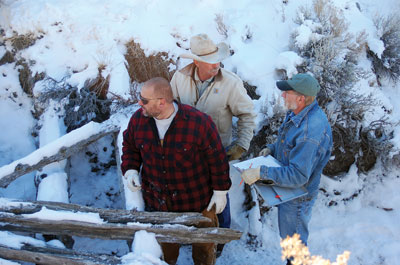Students move frontier bridge to Lander museum
January 1, 2012

Central Wyoming College students in Todd Guenther’s Introduction to Archaeology class plan to rebuild the “last reminder of the frontier era” in Lander this spring.
On a cold and snowy day last fall, students and museum volunteers carefully removed and numbered each timber of what is believed to be the last surviving frontier stage coach bridge in the northern Rockies with the intent of re-assembling it on the grounds of the Museum of the American West in Lander.
“It’s not pretty to look at,” said Guenther, a former Lander museum curator. “It’s still the last (stage coach) bridge we’ve been able to document in Wyoming, Montana, Colorado and Idaho.”
Some 15 years ago, Guenther came upon the bridge while exploring on horseback about 25 miles south of Lander. Since the bridge was in the vicinity of Rawlins-to-Lander trail ruts, Guenther assumed it was built for the stage coach company.
Guenther quizzed Jim Sable, a museum volunteer with the Museum of the American West who graduated from Fremont County Vocational High School in Lander in 1939, about the structure.
When Sable was still in high school, he and his parents visited a Crooks Gap rancher named Johnny Kirk. Sable asked the old man about the bridge that spanned a tributary of Hall Creek. Kirk said he built it when he was driving stage coach between Rawlins and Lander.
Kirk told Sable that the stage drivers used that bridge for a rest stop and that women would go upstream to relieve themselves and the men would go downstream.
Guenther explored the possibility of preserving the bridge with the State Historic Preservation Office and the Bureau of Land Management since it resided on BLM property. Last year, he mentioned it to his students and their interest was immediately piqued.
“Even though it’s ugly, it’s historically significant,” Guenther said.
The class discussion centered on what artifacts were worthy of saving. “You can’t save everything, but they decided they wanted to save the bridge,” Guenther said of his students.
Within two days, the students found donors to support their preservation effort and raised $500 to cover the expenses of transporting the bridge piece by piece to Lander. The donations also will pay for interpretative signs once the bridge is re-assembled.
Nesting eagles in the vicinity of the bridge prevented the bridge’s removal last summer during Guenther’s annual Field Studies program. “We had to wait until the babies grew up and flew away,” he said.
The Rawlins to Lander stage route was reported to be one of the longest remaining in the early 1900s. John L. Cowan wrote an article in the Western Christian Advocate entitled “The Longest Stage Route in America.”
For three days, passengers of the Rawlins to Lander stage would cling to their seat, bumping through some of the very worst of Wyoming Bad Lands rolling over and between utterly naked hills and around imposing buttes and rock formations, teetering on the edge of yawning gulches, bowling past irrigated farms and ranches, skirting the edge of picturesque Indian villages from which stolid braves and bashful squaws and sly papooses gaze forth in mild curiosity; skating on two wheels over the hock back and finally winding up with a grand flourish in the sleep hamlet of Lander, the four-horse stage coaches make their trips with a regularity, an indifference to wind and weather, and a fidelity to schedules that reflect credit upon the drivers who thus bid defiance to sandstorms in summer and snowstorms in winter, and all the other varieties of ugly weather of which Wyoming climate is capable.” – John Cowan
The Rawlins to Lander stage company folded after the train came from Casper to Riverton to Lander in 1906. “The railroad totally changed the frontier lifestyle,” Guenther said.
As a result of the hands-on opportunities provided by CWC’s Western American Studies program, many of the students in Guenther’s program have gone to work at archaeological digs in the U.S., Peru, Croatia, Bulgaria and Argentina.
“That’s what’s so cool about this program,” Guenther said. “The students get a lot of practical experience so they can go to exotic places around the world and grow their careers. While they were here they got experience doing things that other students only read about in text books.”
This spring, the archaeology students will re-assemble the bridge at the Lander museum. Though some of the deck logs were missing, Guenther said about 99 percent of the bridge is intact.